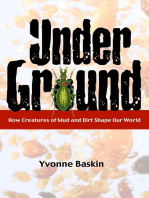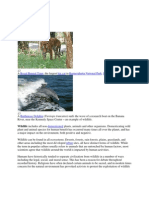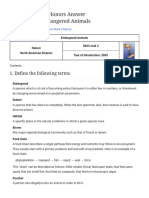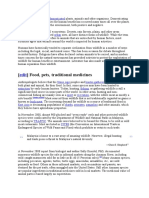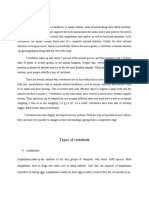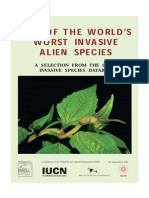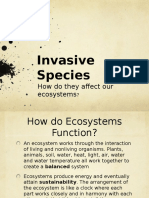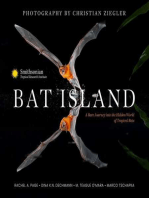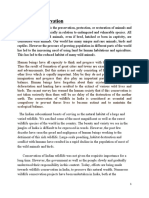0 ratings0% found this document useful (0 votes)
21 viewsExotic Species
Exotic Species
Uploaded by
nilkanthretailenterpriseltdCopyright:
© All Rights Reserved
Available Formats
Download as PPTX, PDF, TXT or read online from Scribd
Exotic Species
Exotic Species
Uploaded by
nilkanthretailenterpriseltd0 ratings0% found this document useful (0 votes)
21 views8 pagesCopyright
© © All Rights Reserved
Available Formats
PPTX, PDF, TXT or read online from Scribd
Share this document
Did you find this document useful?
Is this content inappropriate?
Copyright:
© All Rights Reserved
Available Formats
Download as PPTX, PDF, TXT or read online from Scribd
Download as pptx, pdf, or txt
0 ratings0% found this document useful (0 votes)
21 views8 pagesExotic Species
Exotic Species
Uploaded by
nilkanthretailenterpriseltdCopyright:
© All Rights Reserved
Available Formats
Download as PPTX, PDF, TXT or read online from Scribd
Download as pptx, pdf, or txt
You are on page 1of 8
Exotic Species
Exotic is the adjective most commonly used by conservation biologists
to describe a species living outside of its native range. However, you will
often encounter the terms introduced species, nonindigenous species,
and nonnative species and many botanists refer to alien or adventive
plants. Invasive species is very common too; this term usually refers to
exotic species that have successfully invaded (or are likely to invade) an
ecosystem, causing significant ecological, economic, or human health
problems. As we will see, most exotic species are not actually invasive.
Some people define “invasive” to also include native species that
exhibit these characteristics, but most people limit the term to exotics.
A final point on definitions: biologists consider a species to be exotic if it
is outside of its natural geographic range (i.e. the geographic range it
would occupy without human interference) regardless of political
boundaries, while most nonbiologists are likely to call a species exotic if
it is from a different nation or state.
How Do Species Move? Stowaways: Many of the species that have
been transported around the globe were stowaways, species that we would
have gladly left behind. The Norway rat, house mouse, and black rat (often
called the ship rat) come to mind first. In human terms, these three species
cause billions of dollars in losses each year; they have also been major culprits
in the extinction of many species, particularly on islands. Conservation
biologists often overlook microorganisms as invasive exotics, but the
stowaways we carry in our bodies have had extraordinarily profound effects;
for example, pathogens carried by European explorers and colonists have
decimated native peoples around the world . Similarly, disease organisms
afflicting wild life and domestic plants and animals have been spread far and
wide by our activities (the rabies virus and chestnut blight to name just two of
many). Stowaways often go unnoticed because they are small and
inconspicuous. Many insects have been spread widely, traveling as eggs and
pupae on food, logs, and other objects. European earthworms probably arrived
in North America in soil clinging to the roots of apple trees and other plants.
(Most people do not realize that virtually all earthworms are exotic in Canada
and the northern United States.
The roadsides of North America and New Zealand are
dominated by plants from Europe such as dandelions,
plantains, and certain thistles, most of which probably arrived
as seeds in packing material or hay carried to feed livestock
during voyages. A German researcher scraped the mud off a
single car on four occasions during one growing season and
3926 seedlings of 124 species germinated in these samples.
Probably the greatest flood of exotic organisms involves small
marine organisms – plankton and the planktonic offspring of
larger species – that arrive by the millions in the ballast water
of ships. It is one thing for governments to regulate deliberate
introductions; it is far more difficult to control accidental
introductions of stowaways.
Subsistence and Commerce: Most deliberate attempts to mingle the
world’s biota have been motivated by our need for food, especially
familiar food. Colonists everywhere have brought their own domestic
plants and animals with them, and often sent new plants and animals
back to their homelands. Species used for food dominate the list of
planned introductions, but other needs have also prompted
introductions. Exotic tree species have been planted widely as
sources of lumber, fiber, and fuel, sometimes growing better than
they did in their native environment (Richardson 1998; Petit et al.
2004). For example, Monterey pine, an uncommon species that is
little used for lumber in its native California, is a prized plantation
species in Australia and many other countries. Conversely, Australian
eucalypts are common in California and elsewhere. The
consequences of these introductions are usually quite localized as
long as these species remain domestic. However, some of these
species escape into the wild; they become feral. Horses, donkeys,
and pigs are now feral in many places in the New World,
Recreation: Sport hunters and anglers have been very active in
the planned introductions of exotic wild species. Anglers have been
particularly ambitious in this regard, carrying fish by the bucket and
truckload to water bodies all over the world . In California 50 of the
133 freshwater fish species are not native to the state, and
sportfishing was the leading impetus for most of these
introductions. Among terrestrial creatures, game birds have been
favorites for introductions. In Hawaii alone 75 different species of
game birds (chiefly Galliformes, i.e. pheasants, quail, partridges,
etc.) have been introduced, although only 17 species were
successfully established. One of the world’s most popular game
birds, the ringnecked pheasant, is now more common in Europe and
North America than in its native range in Asia. Wild and domestic
pigs are the same species, and between domestic individuals going
feral and wild individuals being introduced by hunters, pig hunting is
possible throughout much of the world.
Whimsy or Aesthetics: Acclimatization societies – social groups
whose sole purpose was to introduce new species – were quite
popular among European colonists during the late nineteenth and
early twentieth centuries. Indeed, in New Zealand, many of these
groups are still active, although they have changed their names to
Fish and Game Councils to recognize their broader interests and in
deference to the negative side of introducing exotics. To a large
degree these groups were motivated by a love of nature for the
species they left behind in Europe, and European songbirds were
their favorite subjects. On the whole they were not very successful,
with notable exceptions like the starling, but in New Zealand they
had, from their perspective, good luck. A naturalist traveling through
New Zealand today will see far more songbirds native to Europe than
New Zealand songbirds. Importing plants because of their ornamental
beauty and importing animals as pets could be classified as motivated
by aesthetics or commerce or recreation.In Pakistan different plant
species were also introduced.
SCIENCE: To study species closely scientists often establish breeding colonies in
their laboratories. Sometimes these species are from outside their native
range, and sometimes they escape. The gypsy moth is probably the most
notorious example of this. It is now widespread in forests of the United States
after escaping in 1869 from the lab of a scientist who imported it from Europe,
hoping to develop a silk industry in New England.
Biological Control : Many exotic species have been introduced to control
invasive exotics that were introduced earlier. Sometimes, this practice works
quite well, even though it is making the best of a bad situation. Unfortunately,
poorly planned introductions often make a bad situation worse . Rats and
rabbits introduced to islands can reach plague proportions, but introducing
their predators (e.g. stoats, ferrets, and weasels in New Zealand and
mongooses in Hawaii and the West Indies) was worse than useless. The rats
and rabbits proved largely immune to the predators, but the predators
wrought havoc on other species, notably ground-nesting birds. In Australia, red
foxes were introduced initially for recreational hunting but have had some
effect on introduced rabbits; unfortunately, the foxes are far more effective as
predators on native marsupials and ground-nesting birds.
Habitat Change: When we think of exotics we usually think of
species actually transported by people, deliberately or
accidentally, but we could also include species that were able to
expand their ranges themselves because of human changes to the
environment. For example, construction of the Welland Ship Canal
allowed sea lampreys, a parasitic fish, to bypass Niagara Falls and
invade the upper Great Lakes. When the Suez Canal was opened
in 1869, it permitted many species from the Red Sea to invade the
eastern Mediterranean. Similarly, construction of a sea-level canal
across the isthmus of Panama could allow a large-scale exchange
of Pacific and Atlantic species. Under this definition, the coyote,
mallard, brown-headed cowbird, and a host of prairie plants
(especially members of the aster and grass families) are exotic
species in the eastern United States because opening the eastern
forests for agriculture allowed them to expand their ranges from
the west. In the case of the coyote, this process was facilitated by
our extirpation of wolves, which can compete with coyotes.
You might also like
- Let The Streets Run Red (Vampire The Masquerade 5th Edition)Document252 pagesLet The Streets Run Red (Vampire The Masquerade 5th Edition)Matthew Scott Collins100% (10)
- ELLT Reading Test 2 PDFDocument2 pagesELLT Reading Test 2 PDFBrijbala JainNo ratings yet
- Warhol Vanishing AnimalsDocument90 pagesWarhol Vanishing Animalsocr2103No ratings yet
- Ihn General Training Reading Practice Test 6 Section 1 Questions 1 - 13Document14 pagesIhn General Training Reading Practice Test 6 Section 1 Questions 1 - 13Anonymous f5qGAcZYNo ratings yet
- A Plague of Rats and Rubbervines: The Growing Threat Of Species InvasionsFrom EverandA Plague of Rats and Rubbervines: The Growing Threat Of Species InvasionsNo ratings yet
- Wildlife 1Document6 pagesWildlife 1Manoj SharmaNo ratings yet
- Evolution of Human BeingsDocument10 pagesEvolution of Human BeingsJAYACHANDRANNo ratings yet
- A Joosr Guide to... The Sixth Extinction by Elizabeth Kolbert: An Unnatural HistoryFrom EverandA Joosr Guide to... The Sixth Extinction by Elizabeth Kolbert: An Unnatural HistoryNo ratings yet
- Book Review of Ecological ImperialismDocument17 pagesBook Review of Ecological ImperialismjeffstgalNo ratings yet
- Quail, Buttonquail and Plains-wanderer in Australia and New ZealandFrom EverandQuail, Buttonquail and Plains-wanderer in Australia and New ZealandNo ratings yet
- Adventist Youth Honors Answer Book - Nature - Endangered Animals - Wikibooks, Open Books For An Open WorldDocument11 pagesAdventist Youth Honors Answer Book - Nature - Endangered Animals - Wikibooks, Open Books For An Open WorldMilkah WairimuNo ratings yet
- Species and ExtinctionDocument8 pagesSpecies and ExtinctionAisha sumreenNo ratings yet
- Faculty of Medical Scienses-: University 'Goce Delcev'' StipDocument8 pagesFaculty of Medical Scienses-: University 'Goce Delcev'' StipStojance IlievskiNo ratings yet
- Wildlife Includes All NonDocument5 pagesWildlife Includes All NonchhapdeyaarNo ratings yet
- Alien Invasions WildlifeDocument3 pagesAlien Invasions WildlifeLauraMercadoIzquierdoNo ratings yet
- Alkaloids Hallucinogens Convulsants Nerve Poisons VasoconstrictorsDocument4 pagesAlkaloids Hallucinogens Convulsants Nerve Poisons Vasoconstrictorskbarn389No ratings yet
- PinnipedDocument4 pagesPinnipedSandri Alexandra NegreanuNo ratings yet
- North American Porcupine Porc-Épic D'amérique Du Nord Puerco EspínDocument6 pagesNorth American Porcupine Porc-Épic D'amérique Du Nord Puerco EspínitsankurzNo ratings yet
- The Complete Field Guide to Stick and Leaf Insects of AustraliaFrom EverandThe Complete Field Guide to Stick and Leaf Insects of AustraliaRating: 4.5 out of 5 stars4.5/5 (2)
- Extinction: What Happened to the Dinosaurs, Mastodons, and Dodo Birds? With 25 ProjectsFrom EverandExtinction: What Happened to the Dinosaurs, Mastodons, and Dodo Birds? With 25 ProjectsNo ratings yet
- Biological InvasionDocument1 pageBiological InvasionjahangeerecogreenNo ratings yet
- Vertebrate and InvertebratesDocument9 pagesVertebrate and InvertebratesgwenethzNo ratings yet
- Pinnels ResearchDocument1 pagePinnels Researchcelesis600No ratings yet
- Canids of the World: Wolves, Wild Dogs, Foxes, Jackals, Coyotes, and Their RelativesFrom EverandCanids of the World: Wolves, Wild Dogs, Foxes, Jackals, Coyotes, and Their RelativesRating: 5 out of 5 stars5/5 (2)
- The 100 World's Worst Alien Invasive SpeciesDocument11 pagesThe 100 World's Worst Alien Invasive SpeciesCaetano SordiNo ratings yet
- 100 of The World'S Worst Invasive Alien SpeciesDocument11 pages100 of The World'S Worst Invasive Alien SpeciesManikandan VijayanNo ratings yet
- Dauphine The Tres Chimbadas Otter Project 2001Document6 pagesDauphine The Tres Chimbadas Otter Project 2001Jeff CremerNo ratings yet
- Frogs vs. Toads: CaeciliansDocument2 pagesFrogs vs. Toads: CaeciliansZonny Zivins PresentsNo ratings yet
- Some Rare OccurrencecurrcurrDocument2 pagesSome Rare OccurrencecurrcurrSinh Vạn VũNo ratings yet
- Txhi Term PaperDocument15 pagesTxhi Term Paperapi-239656972No ratings yet
- Chapter 2 Snakes of Papua New GuineaDocument23 pagesChapter 2 Snakes of Papua New GuineaIrfan Haidar BasyirNo ratings yet
- hand for my schneDocument17 pageshand for my schnesushila3231No ratings yet
- The Parrot: An Owner's Guide to a Happy Healthy PetFrom EverandThe Parrot: An Owner's Guide to a Happy Healthy PetRating: 2 out of 5 stars2/5 (2)
- FeralDocument8 pagesFeralsteve34567No ratings yet
- ScienceDocument2 pagesScienceJunseob LeeNo ratings yet
- Invasive SpeciesDocument26 pagesInvasive Speciesapi-350092850No ratings yet
- The Accidental InvasionDocument15 pagesThe Accidental Invasionapi-551522004No ratings yet
- Bat Island: A Rare Journey into the Hidden World of Tropical BatsFrom EverandBat Island: A Rare Journey into the Hidden World of Tropical BatsNo ratings yet
- Written ReportDocument10 pagesWritten ReportvalNo ratings yet
- Hylogeography of Inches and Parrows: Antonio Arnaiz-Villena, Pablo Gomez-Prieto and Valentin Ruiz-del-ValleDocument54 pagesHylogeography of Inches and Parrows: Antonio Arnaiz-Villena, Pablo Gomez-Prieto and Valentin Ruiz-del-ValleKakatuar KakatuaNo ratings yet
- What's The Difference Between Native and Endemic SpeciesDocument3 pagesWhat's The Difference Between Native and Endemic SpeciesGhaier Kazmi100% (1)
- Killer Whales Thesis StatementDocument5 pagesKiller Whales Thesis Statementafcnoxdhv100% (2)
- Adaptive RadiationDocument7 pagesAdaptive RadiationSerenaUchihaNo ratings yet
- Vertebrates Fertilization Development Scales Turtles Tuatara Lizards Snakes Crocodiles Birds Archosauria BirdDocument8 pagesVertebrates Fertilization Development Scales Turtles Tuatara Lizards Snakes Crocodiles Birds Archosauria BirdJhuliane RalphNo ratings yet
- Mass ExtinctionDocument22 pagesMass ExtinctionTheon SantiagoNo ratings yet
- Jared Diamond and The Theory of Geographic LuckDocument2 pagesJared Diamond and The Theory of Geographic Luckapi-198321679No ratings yet
- Wildlife Conservation: Wildlife Conservation Is The Preservation, Protection, or Restoration of Animals andDocument41 pagesWildlife Conservation: Wildlife Conservation Is The Preservation, Protection, or Restoration of Animals andKiran JoshiNo ratings yet
- Brown and Sax 2014 - An Essay On Some Topics Concerning Invasive Species PDFDocument7 pagesBrown and Sax 2014 - An Essay On Some Topics Concerning Invasive Species PDFSabrinaNo ratings yet
- Animal ExtinctionsDocument8 pagesAnimal ExtinctionsKanishkNo ratings yet
- Extinct AnimalsDocument13 pagesExtinct AnimalsIyliahNo ratings yet
- ??????? ?? ???-? ????-?Document6 pages??????? ?? ???-? ????-?ravichandra dasariNo ratings yet
- Wa0008.Document12 pagesWa0008.Dark FroztNo ratings yet
- Ondal and Princess PyeonggangDocument24 pagesOndal and Princess PyeonggangArvie Nicole SalesNo ratings yet
- Free D&D Adventure - Retrieve Stolen Festival Supplies in 'The Great Jigow Scavenger Hunt!' - Posts - D&D BeyondDocument8 pagesFree D&D Adventure - Retrieve Stolen Festival Supplies in 'The Great Jigow Scavenger Hunt!' - Posts - D&D BeyondCarlos Costa CoxNo ratings yet
- Student's Corner: Nemanja Palić, IV1, Medicinska Škola, KragujevacDocument2 pagesStudent's Corner: Nemanja Palić, IV1, Medicinska Škola, KragujevacBranka DečkovićNo ratings yet
- A Song of Ice and Fire Roleplaying - Corebook-20-40-15-16Document2 pagesA Song of Ice and Fire Roleplaying - Corebook-20-40-15-16Black JediNo ratings yet
- USCCA Concealed Carry GuideDocument28 pagesUSCCA Concealed Carry GuideJason Ryan PerezNo ratings yet
- Road Travel Campaigns for Any Fantasy TTRPG - Part 1Document29 pagesRoad Travel Campaigns for Any Fantasy TTRPG - Part 1flipper.el.rey.del.mar.y.del.malNo ratings yet
- HuntersEd EbookDocument23 pagesHuntersEd EbookTeam WinNo ratings yet
- Adv WhispersoftheDarkFey 2Document15 pagesAdv WhispersoftheDarkFey 2Daniel100% (1)
- 1079-C-6626-The Tiger King Assignment 1Document5 pages1079-C-6626-The Tiger King Assignment 14hz24m7f7sNo ratings yet
- .300 Remington Ultra Magnum - WikipediaDocument5 pages.300 Remington Ultra Magnum - WikipediaDOMINGOSERPA4148No ratings yet
- Bore and Groove DiametersDocument1 pageBore and Groove DiametersDale WadeNo ratings yet
- The Kingdom of ChraceDocument10 pagesThe Kingdom of ChraceLeo GunnemarssonNo ratings yet
- Chapter 3-The Bunun People: Huang References Mabuchi (1951: 44)Document16 pagesChapter 3-The Bunun People: Huang References Mabuchi (1951: 44)John KAlespiNo ratings yet
- Ruislip and Surrounding Isles: Luke GearingDocument19 pagesRuislip and Surrounding Isles: Luke GearingJeanJ7TNo ratings yet
- ASSASSINDocument10 pagesASSASSINJorge RocketNo ratings yet
- The Start & End of Uluu ThalongDocument20 pagesThe Start & End of Uluu ThalongDaniel Rech CorrêaNo ratings yet
- The World of the Unknown - GhostsDocument34 pagesThe World of the Unknown - GhostsEric TildenNo ratings yet
- Lost in The Wilderness Adv Toolkit (NeoGeekRev)Document25 pagesLost in The Wilderness Adv Toolkit (NeoGeekRev)Frejth King (Lord of Thorns)75% (4)
- 1.6 ERA OF 303: Omega Plan (Season 1) "The Kandahar Giant" Ep 6Document86 pages1.6 ERA OF 303: Omega Plan (Season 1) "The Kandahar Giant" Ep 6Jono KaragiannisNo ratings yet
- Notes .Lumber RoomDocument3 pagesNotes .Lumber Roomhawwai who? iamgoodHowAreyou?No ratings yet
- How To Be A Hunting Guide and Survive in The JungleDocument6 pagesHow To Be A Hunting Guide and Survive in The JungleLuqman HakimNo ratings yet
- Gnoll (Playable) : Savage HuntersDocument3 pagesGnoll (Playable) : Savage HuntersAlhor WolfNo ratings yet
- Foren 6Document3 pagesForen 6aron agNo ratings yet
- Delhi Public School, Ruby Park, Kolkata SESSION: 2020-21 English Study Material For The Month of November Class-2 LiteratureDocument2 pagesDelhi Public School, Ruby Park, Kolkata SESSION: 2020-21 English Study Material For The Month of November Class-2 LiteratureSOUNIKA MANDALNo ratings yet
- Fire and Ice - Peter FehervariDocument88 pagesFire and Ice - Peter FehervariErick Galindo100% (2)
- Mushroom Foraging GuideDocument3 pagesMushroom Foraging GuideDavid Miguel RebeloNo ratings yet
- Legends Adventurers 2nd PrintingDocument40 pagesLegends Adventurers 2nd PrintingMihály JuhászNo ratings yet
- CH-2 Tiger KingDocument42 pagesCH-2 Tiger Kingrti tauruNo ratings yet




